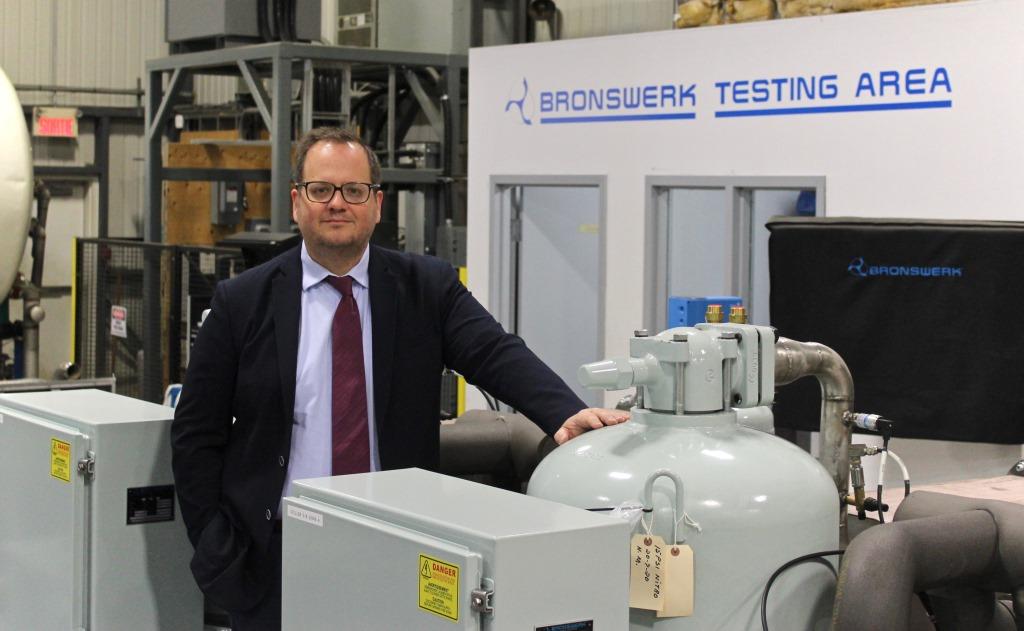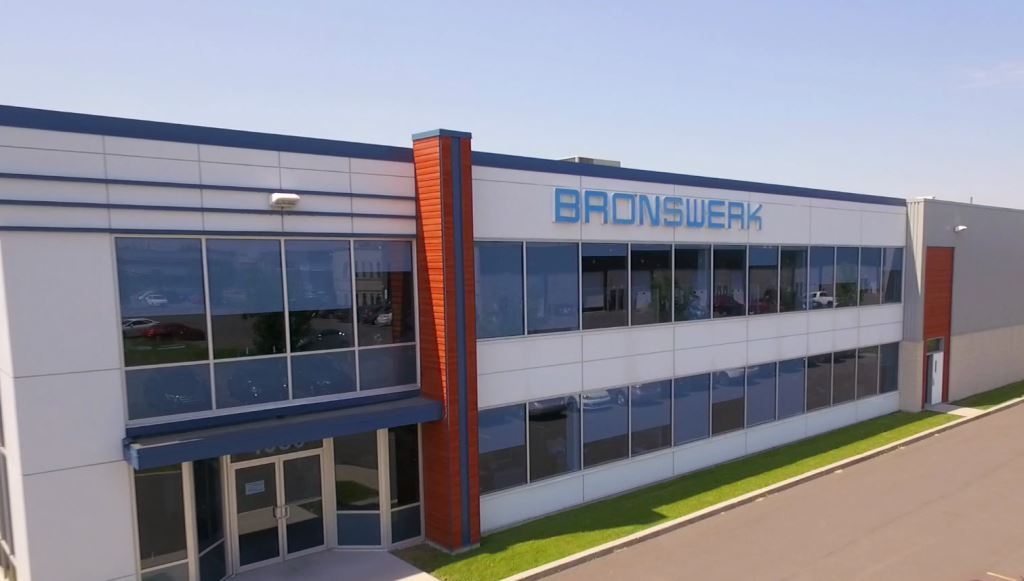EXECUTIVE VIEWPOINT - Francis Fontaine
FRANCIS FONTAINE
CEO, Bronswerk Group
CDR’s Quebec Bureau Chief, Peter Diekmeyer, recently interviewed this leading shipboard HVAC-R /climate engineering executive about how his company is leveraging defence procurements to foster international exports. Here is that conversation in full.
 CDR: Hi Francis, thank you for speaking with us. Can you start off by giving our readers an update on what’s new at Bronswerk?
CDR: Hi Francis, thank you for speaking with us. Can you start off by giving our readers an update on what’s new at Bronswerk?
FF: Like much of the defence industry our focus has been on servicing existing Navy and Coast Guard clients, while adjusting to threats and opportunities related to the COVID-19 pandemic. We are travelling less, making more extensive use of video conferencing technology and doing more from home. But we are also thinking longer-term about new ways to leverage innovative Heating, Ventilation, Air-Conditioning and Refrigeration (HVAC-R) capabilities to help rebuild Canada’s aging defence infrastructure in a post-pandemic world.
CDR: Why should governments invest in defence when times are so tough?
FF: During the Great Depression of the 1930s governments discovered that investing in capital stock was one the best ways to create high value jobs that generate lasting benefits. Prioritizing the ships planned as part of Canada’s National Shipbuilding Strategy, many of which would generate utility for generations and create spinoff effects that ripple throughout a range of national supply chains, would be a logical step. The Government’s Strong Secure Engaged defence policy identified a range of pressing needs. The question comes down to timing. Canada’s economy has been hit hard by recent developments. We are going to desperately need new economic activity in the coming years.
CDR: What is your primary business focus?
FF: Bronswerk is one of Canada’s leading Naval original equipment manufacturers and we market commercial and military HVAC-R solutions through a network of twelve international offices. We supply a full range of shock, vibration, and noise qualified equipment and manage the entire life-cycle process from concept to commissioning. That includes installation and in-service support work that creates jobs, many of which are around as long as the ships themselves.
For example, we continue to employ people in Vancouver and Halifax who are doing work on Canadian frigates that were built decades ago. However, like many Canadian defence subcontractors, our strong international presence has also enabled us to build significant export capabilities. We produce systems that can adjust to varied rigorous sea conditions ranging from the Persian Gulf to the Arctic Ocean, while ensuring crew comfort and safety in climatically controlled environments.
CDR: What are Bronswerk’s best-selling products and services?
FF: Bronswerk’s internal structure is composed of two major business units. Our engineering team supports shipbuilders and naval architects in design review and proposal generation in accordance with specifications proposed by the Royal Canadian Navy, NAVSEA (the U.S. Naval Sea Systems Command) and other key clients. One of our highest visibility projects relates to work we are doing as a Tier One partner on the Joint Support Ship program which is currently being built by Seaspan on Canada’s West coast. The keel on the first of two ships has been laid. We delivered some equipment last year and will start installing it in the coming weeks.
Bronswerk also offers a range of products including NBC (nuclear, chemical, biological) filtration systems, ammunition and radar cooling products and refrigeration units, such as its modular option known as the CUBE. Bronswerk is also designing and manufacturing its own HVAC automation and control systems that include MIL and EMI capabilities. We are also building up our obsolescence management services and capabilities, which we project will be in growing demand as production evolution cycles shorten.
CDR: As the CEO of a leading Naval OEM, what some of the primary trends you have witnessed in your industry?
FF: The Canadian defence sector, particularly national shipbuilding supply chains, continues to work in increasingly closer horizontal and vertical partnerships with other industry players, workers, and government. Innovation in a range of areas has also been key. For example we revolutionized global marine chiller standards with our oil-free chillers, which meet the highest Navy shock, vibration, noise, and EMI standards. They are also cost-effective and environmentally friendly (they use a low-pressure refrigerant) and are designed to operate under extreme ship movements in hot, salt-laden atmospheres. Projected upcoming procurements such as the Canadian Surface Combattants, as well and medium and Polar-scale icebreakers are also on the horizon.

CDR: How did Bronswerk’s long history in Canada drive your current business philosophy?
FF: Bronswerk was founded in1947 and was originally headquartered in The Netherlands. The company established its first Canadian foothold in the early 1980s following the award of the design and supply contract for the new Canadian Patrol Frigate program. Bronswerk’s Canadian subsidiary grew steadily during the ensuing years, and corporate executives quickly realized that they could leverage its growing base of local talent to increase its international presence. In 2006 Bronswerk became Canadian controlled (establishing head office in Brossard, Quebec). During subsequent years the company gradually set up and now maintains permanent offices on both Canadian and U.S. coasts, as well as in the Gulf of Mexico, France, Germany, Turkey, Singapore, and in Australia.
CDR: Next year Bronswerk will be celebrating its 75th anniversary. What do you think is the key to Bronswerk’s success over the years?
FF: Our focus on developing, training, and keeping the best talent we can find gives us a consistent leg up. Bronswerk’s team has developed mastery of a range of standards, which enables us to add significant value at the ship design process, which is the key first step prior to sourcing the right equipment. But that’s just the start, we also have to deliver. Our use of the Project Management Body of Knowledge (PMBOK) method and the associated project roadmap processes have been key to our ability to deliver solutions on time and on budget. This approach, which was created by the Project Management Institute (PMI), is consistent with our ISO 9000 certification of management standards.
We support customers throughout project life cycles, using tools such as digital twins of the ships that our equipment is in. Finally, the fact that we are family owned and free from the pressures of quarterly earnings calls, has enabled the company to focus on longer-term strategies such as fostering innovation through consistent investments in research and development.
CDR:What is in the future for Bronswerk?
FF: Bronswerk’s business model is based on meeting growing demand to develop local expertise and content in our project implementations. Fostering the autonomy of our different international offices is also an interesting, but highly fruitful challenge, which paid off significantly in our ability to support current and new clients during the reduced travel environment related to the COVID-19 response.
Finally, Bronswerk is recognized as a reliable partner of choice. This stems in part from the fact that we benefit from a financially sound, ownership structure that thinks strategically, has fostered stability in its workforce and knowledge base and has demonstrated consistent success in bringing Navy and Coast Guard projects to life-cycle fruition.
CDR:What are key metrics that you are looking out for?
FF: Internationally, we are currently working on a design for the first of a projected three heavy icebreakers (Polar Security Cutter) in the U.S. However, some of our most important conversations that we will be having as an industry are with local governments. Canada has one of the largest coastlines in the world, and with global tensions rising and the stakes continuing to grow in regions such as the Arctic, our naval presence will be more important than ever. We need a clear commitment that these factors will be addressed.
We are also all looking forward to resuming travel. I continue to go to the office two days a week. But optimizing the large-scale Heating, Ventilation, Air-Conditioning and Refrigeration projects that we specialize in requires the subtle interactions involved in face-to-face meetings.
CDR:Thank you.
Peter Diekmeyer is CDR’s Quebec Bureau Chief

